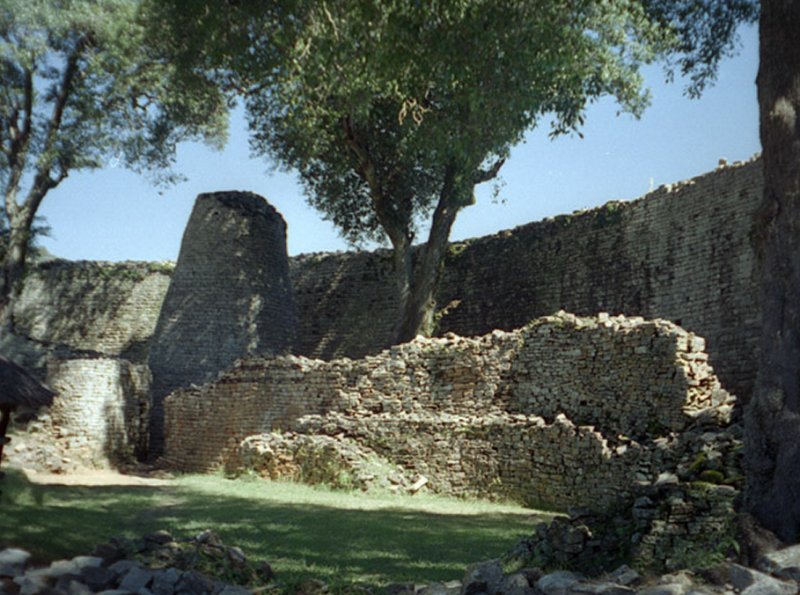Great Ruins of Zimbabwe: Unsolved Secrets Of Bizarre Buildings Without Windows And Doors
A. Sutherland - AncientPages.com - The ruins extending over approximately 385,000 square miles are located in Zimbabwe, on the high plateau of southern Africa.
The ruins contain the remains of about five hundred perplexing structures. Most of them are of conical shape, but it is not their shape that makes them so bizarre.
Inside of the Great Enclosure which is part of Great Zimbabwe ruins. Image credit: Jan Derk - Public domain
The lack of doors and windows and other openings made them useless for humans. The conical towers are thirty-three feet thick, and some elliptical walls are three stories tall.
"A square fortress, masonry within and without, built of stones of marvelous size, and there appears to be no mortar joining them," wrote Joao de Barros, of the first great Portuguese historians from the sixteenth century. He also mentioned the locals - illiterate people in the area - who referred to the ruins as Zimbabwe.
No one knew when and who built them, but these people were convinced that the structures were the devil's work. These strange buildings were constructed of rock, split into separate blocks, and put together without using mortar.
In 1868, the German traveler and explorer Adam Renders got lost in a deep South African jungle and accidentally came across the remarkable ruins near Lake Victoria.
Towers of Great Zimbabwe showing unmortared, dressed masonry. Taken c.1996 on film. Image credit: JackyR - CC BY-SA 3.0
Trying to get out of there, he was moving along the walls for a while, having the impression of going in circles. At that time, he did not know that he had found the Great Ruins of Zimbabwe.
Three years later, Karl Mauch (1837 - 1875), a German explorer, adventurer, and one of the first white men to find gold in the region, decided to research ruins that could belong to a legendary land, Ophir, famous for its gold mines and governed by one of the vassals of the Queen of Sheba. Any convincing proof of his assumption has never been found.
Adam Renders, who came upon the site, had perhaps no theories on its origin. But he was thinking about these curious ruins often and anxiously. He stayed for the rest of his life there and died in Zimbabwe.
Who were the unknown builders of these structures? What was the original purpose of these enigmatic buildings?
Among many theories, one suggested that the builders came from North Africa. Jewels, pearls, bracelets from Arabia, artwork from India, and at least one thousand years old Chinese porcelain were found, but no inscriptions could shed some light on the great mystery of the ruins.
"No mortar was employed, but the stone was dressed and squared by the hammer. Amongst the ruins numbers of relics have been discovered, including statuettes of Astarte or Venus in hawk form; Phallic symbols of various dimensions; bowls, trinkets, etc..." German ethnologist and archaeologist, Leo Frobenius said about the greatness of ruins.
Curved passageways circling the Great Enclosure Great Zimbabwe. Image credit: amanderson2 - CC BY 2.0
Did a lost race construct Zimbabwe? Had the ruins an astronomical purpose? Did a prehistoric race like the builders of Stonehenge create the conical towers? These structures could not have been intended to serve humans without doors, windows, or other openings.
On the citadel, some soapstone birds (eagles) have been found, placed on heavy five-foot-high stone pedestals similar to the Egyptian statues of falcon-headed Horus piloting his flying vehicle. What did the soapstone eagles from Great Zimbabwe Ruins symbolize?
Skillfully put together, the walls and towers of the Great Zimbabwe are evidence of power, knowledge, and a well-organized settlement. They are impressive monuments to their creators.
The puzzling origin of Zimbabwe's bizarre buildings remains a mystery.
Written by – A. Sutherland AncientPages.com Staff Writer
Updated on January 24, 2023
Copyright © AncientPages.com All rights reserved. This material may not be published, broadcast, rewritten or redistributed in whole or part without the express written permission of AncientPages.com
More From Ancient Pages
-
 Scientists Question Whether Meat Eating Really Changed Human Evolution
Archaeology | Jan 25, 2022
Scientists Question Whether Meat Eating Really Changed Human Evolution
Archaeology | Jan 25, 2022 -
 ‘Wheel Of Giants’: Mysterious Complex Of Circles – Prehistoric ‘Stonehenge’ Monument In The Middle East
Featured Stories | Mar 29, 2019
‘Wheel Of Giants’: Mysterious Complex Of Circles – Prehistoric ‘Stonehenge’ Monument In The Middle East
Featured Stories | Mar 29, 2019 -
 Earliest Record Of An Aurora Discovered In The Bamboo Annals
Archaeology | Apr 15, 2022
Earliest Record Of An Aurora Discovered In The Bamboo Annals
Archaeology | Apr 15, 2022 -
 Artifacts Discovered In Ancient Florida Sinkhole Can Re-Write History Of North America
Archaeology | May 14, 2016
Artifacts Discovered In Ancient Florida Sinkhole Can Re-Write History Of North America
Archaeology | May 14, 2016 -
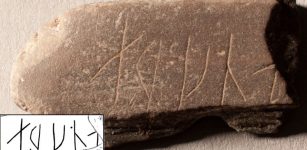 Puzzling Runic Inscription Dated To 1050-1500 AD Unearthed In Oslo, Norway
Archaeology | Dec 13, 2017
Puzzling Runic Inscription Dated To 1050-1500 AD Unearthed In Oslo, Norway
Archaeology | Dec 13, 2017 -
 Mythical Kingdom Of Prester John – Did It Exist?
Featured Stories | Mar 21, 2016
Mythical Kingdom Of Prester John – Did It Exist?
Featured Stories | Mar 21, 2016 -
 Roman Shipwreck Carrying Enormous, Rare Cargo Of 1,800-Year-Old Marble Artifacts Found
Archaeology | May 19, 2023
Roman Shipwreck Carrying Enormous, Rare Cargo Of 1,800-Year-Old Marble Artifacts Found
Archaeology | May 19, 2023 -
 15 New Archaeological Finds Unearthed In Pre-Inca Ruins Of Tiwanaku, Bolivia
Artifacts | Jan 27, 2021
15 New Archaeological Finds Unearthed In Pre-Inca Ruins Of Tiwanaku, Bolivia
Artifacts | Jan 27, 2021 -
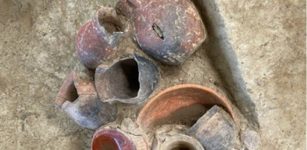 Evidence Of Beer Drinking 9,000 Years Ago In Southern China Discovered
Archaeology | Sep 1, 2021
Evidence Of Beer Drinking 9,000 Years Ago In Southern China Discovered
Archaeology | Sep 1, 2021 -
 Extraordinarily Well-Preserved 3,000-Year-Old Octagonal Sword Unearthed In Germany
Archaeology | Jun 15, 2023
Extraordinarily Well-Preserved 3,000-Year-Old Octagonal Sword Unearthed In Germany
Archaeology | Jun 15, 2023 -
 Surprising Discovery Of Rare Turtle Statue Under Bayon Temple In Angkor, Cambodia
Archaeology | May 2, 2024
Surprising Discovery Of Rare Turtle Statue Under Bayon Temple In Angkor, Cambodia
Archaeology | May 2, 2024 -
 Phurba Dagger: Magical Weapon That Restrains Evil And Harmful Occult Forces
Artifacts | Mar 16, 2019
Phurba Dagger: Magical Weapon That Restrains Evil And Harmful Occult Forces
Artifacts | Mar 16, 2019 -
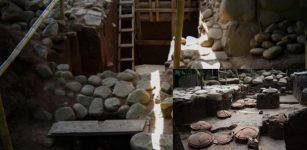 2,000-Year-Old Stela And ‘Laboratory’ Of Early Maya Writing Found In Guatemala
Archaeology | Mar 15, 2020
2,000-Year-Old Stela And ‘Laboratory’ Of Early Maya Writing Found In Guatemala
Archaeology | Mar 15, 2020 -
 Drought Reveals 2,000-Year-Old Rock Carvings In Brazil’s Amazon
Archaeology | Oct 23, 2023
Drought Reveals 2,000-Year-Old Rock Carvings In Brazil’s Amazon
Archaeology | Oct 23, 2023 -
 Sir Christopher Wren – Genius Mind Of Most Influential British Architect Of All Time
Featured Stories | Feb 22, 2016
Sir Christopher Wren – Genius Mind Of Most Influential British Architect Of All Time
Featured Stories | Feb 22, 2016 -
 Most Of Medieval English Heroic Or Chivalric Stories Have Been Lost
Archaeology | Feb 18, 2022
Most Of Medieval English Heroic Or Chivalric Stories Have Been Lost
Archaeology | Feb 18, 2022 -
 Schoolboy Finds A Huge 3,000,000-Year-Old Megalodon Shark Tooth On British Beach
Archaeology | May 9, 2022
Schoolboy Finds A Huge 3,000,000-Year-Old Megalodon Shark Tooth On British Beach
Archaeology | May 9, 2022 -
 Evidence Foreigners Fought Alongside Ancient Greeks Is Challenging Millennia Of Military History
Featured Stories | Jun 1, 2022
Evidence Foreigners Fought Alongside Ancient Greeks Is Challenging Millennia Of Military History
Featured Stories | Jun 1, 2022 -
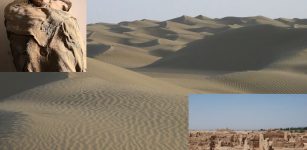 Secret Ancient World Buried Under The Vast Takla Makan Desert
Featured Stories | Jun 1, 2020
Secret Ancient World Buried Under The Vast Takla Makan Desert
Featured Stories | Jun 1, 2020 -
 Ancient Mystery Of The Oghars – An Unusual And Little-Known Lost Race
Civilizations | Mar 19, 2019
Ancient Mystery Of The Oghars – An Unusual And Little-Known Lost Race
Civilizations | Mar 19, 2019

